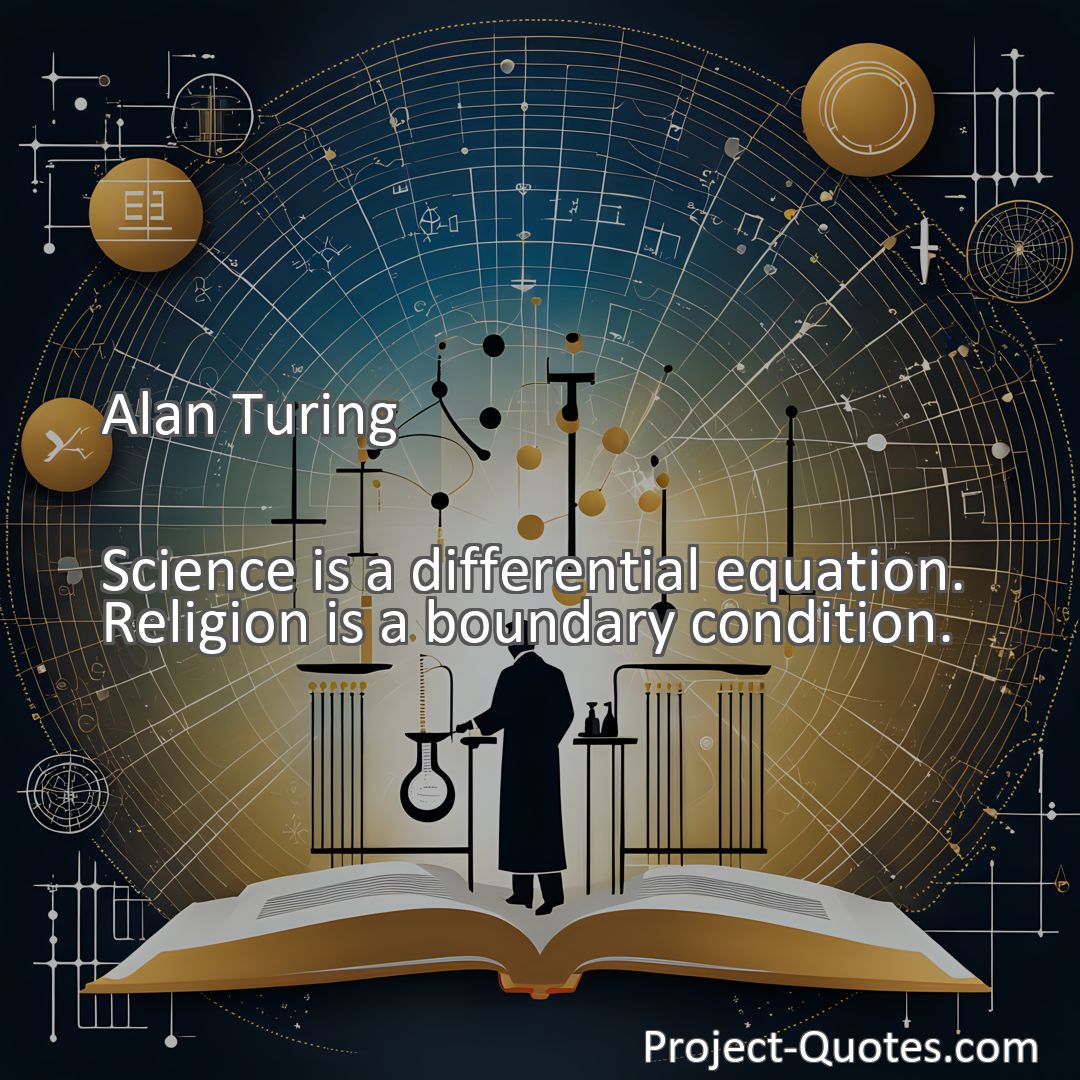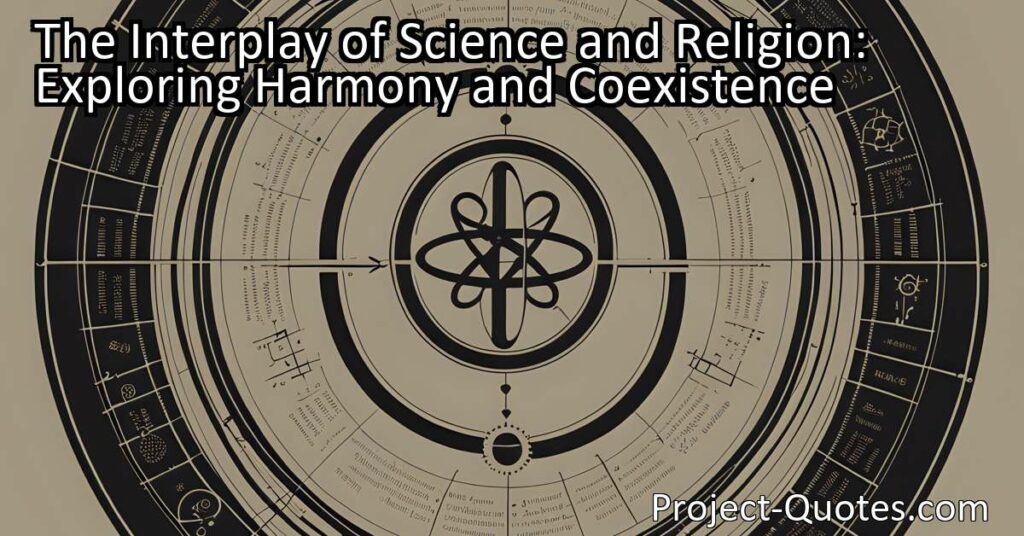Science is a differential equation. Religion is a boundary condition.
Alan Turing
At first glance, science and religion may seem contradictory, but in reality, they have the potential for harmonious coexistence. Science provides a systematic way to understand the natural world through observation and experimentation, while religion addresses profound existential questions and offers spiritual guidance. By recognizing the distinctive roles of science and religion and fostering dialogue between the two, we can develop a comprehensive understanding that enriches our lives on multiple levels.
Table of Contents
Meaning of Quote – Science is a differential equation. Religion is a boundary condition.
Exploring the Interplay of Science and Religion: Uniting Differential Equations and Boundary Conditions
Introduction:
In the realms of understanding our world and the universe, two prominent forces have shaped human knowledge and beliefs: science and religion. Often seen as divergent paths, these worldviews have been debated and discussed throughout history. Alan Turing, a pioneering computer scientist and mathematician, once stated, “Science is a differential equation. Religion is a boundary condition.” Through this quote, Turing offers a thought-provoking analogy that brings together the idea of science as a tool for understanding the natural world and religion as a framework for addressing the spiritual and philosophical aspects of life. In this expanded exploration, we will delve deeper into the significance of Turing’s quote, examining the roles of science and religion, their differences and similarities, and how they can coexist to provide a holistic understanding of our existence.
Science: The Language of Differential Equations:
Science is often described as a systematic way of understanding the natural world through observation, experimentation, and formulating theories based on evidence. Turing’s analogy of science as a differential equation provides an insightful perspective. Differential equations are mathematical tools used to describe and predict change and are fundamental to the laws of physics, engineering, and many other scientific disciplines. Just as differential equations provide precise predictions about natural phenomena, science seeks to untangle the mysteries of the universe by uncovering patterns, laws, and principles.
The beauty of science lies in its ability to continually expand our knowledge and challenge existing beliefs. Through rigorous experimentation and critical thinking, scientists refine their theories and models to provide better explanations for observed phenomena. This constant progress has led to significant advancements in various fields, such as medicine, technology, and space exploration, improving the quality of life for humanity as a whole.
Religion: The Boundary Condition of Life:
While science focuses on understanding the physical world, religion seeks to address the existential questions and provide moral and ethical guidance to individuals and communities. Religion acts as a boundary condition or a framework that helps humans navigate the complexities of life, bringing meaning, purpose, and comfort. It provides answers to questions that science may not have the tools to answer, such as the origins of life, the existence of a higher power, and the nature of consciousness.
Religious traditions across the globe offer individuals a sense of belonging, community, and spiritual enrichment. They provide moral codes, rituals, and practices that guide behaviors and encourage personal growth. Religion offers solace during challenging times, providing hope, peace, and a greater understanding of the human condition. Just as a boundary condition sets limits and constraints on a mathematical model, religion acts as a guiding force in human existence, influencing values, shaping relationships, and addressing questions beyond the scope of scientific investigation.
The Intersection: Science and Religion in Harmony:
Although Turing portrays science and religion as distinct yet complementary concepts, it is essential to recognize that they need not be in conflict. Both can be valuable and necessary aspects of human understanding, offering different but equally important perspectives. In fact, numerous scientists throughout history have found ways to reconcile their scientific endeavors with their religious beliefs.
One way to bridge the gap between science and religion is through the integration of spirituality into scientific inquiry. By acknowledging the limitations of science in addressing existential questions, individuals can bring their personal beliefs and values into their scientific pursuits. This enables a holistic approach that respects both objective empirical evidence and subjective spiritual experiences. Integrating these two perspectives can propel scientific exploration while offering a deeper appreciation for the mysteries of existence.
Moreover, science and religion can come together in exploring the “why” and “how” questions of life. While science primarily focuses on the “how” by offering empirical explanations, religion often addresses the “why” by exploring the purpose and meaning behind natural phenomena. Recognizing the complementary nature of these questions allows individuals to embrace both scientific inquiry and spiritual contemplation, fostering a comprehensive understanding of the world.
The Challenges and the Future Ahead:
Despite the potential for harmony between science and religion, historical conflicts and misunderstandings have fueled divisive debates. These conflicts often arise when either science oversteps its boundaries or religion refuses to adapt to new scientific discoveries. However, as our understanding of the universe evolves, there is room for science and religion to coexist in a mutually respectful manner.
Promoting dialogue and open-mindedness among scientists, theologians, and the general public is crucial for building bridges between science and religion. Encouraging the exploration of philosophical questions within a scientific framework and embracing diverse religious perspectives can foster a richer appreciation for the complexity of human thought and belief systems.
Conclusion:
Alan Turing’s analogy of science as a differential equation and religion as a boundary condition encapsulates the essential aspects of these two ways of understanding the world. Science allows for the analysis and prediction of natural phenomena, focusing on empirical evidence and the formulation of theories. On the other hand, religion provides a framework for addressing deep existential questions and offers spiritual guidance and meaning.
While science and religion may initially appear contradictory, the true beauty lies in their potential for harmonious coexistence. By recognizing the distinctive roles of science and religion and promoting dialogue between these worldviews, we can develop a comprehensive understanding that enriches our lives on multiple levels. As we continue to explore the wonders of the universe, embracing both science and religion may help us unlock the answers to the profound questions that shape our existence.
I hope this quote inspired image brings you hope and peace. Share it with someone who needs it today!


